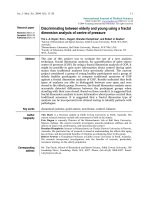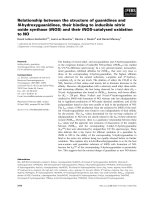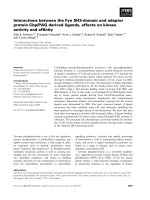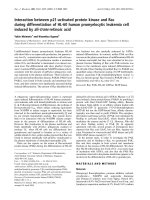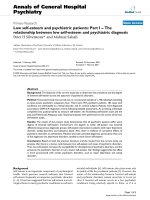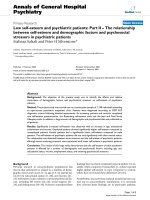Báo cáo y học: "Relationship between Asthma and Rhinitis: Epidemiologic, Pathophysiologic, and Therapeutic Aspects" pps
Bạn đang xem bản rút gọn của tài liệu. Xem và tải ngay bản đầy đủ của tài liệu tại đây (479.73 KB, 7 trang )
81
Epidemiologic Links: Atopy
Asthma and rhinitis are frequently associated with
atopy with preferential sensitization to airborne
allergens. Atopic diseases can manifest them-
selves at different sites on the body and can pre-
sent as urticaria, allergic rhinitis, atopic dermati-
tis, conjunctivitis, food allergy, and asthma.
Allergic Rhinitis and Asthma Prevalence
Allergic rhinitis is an important health problem and
affects up to 40% of the worldwide population.
1,2
Its prevalence in the Canadian population is
between 10 and 25%.
1
Forty percent of allergic
rhinitis patients have asthma, and as much as 94%
of allergic asthma patients have allergic rhinitis.
3–6
In Canada, the current prevalence of asthma is
8.4%
7
whereas worldwide prevalence varies from
1.6 to 37%.
1
Allergic Rhinitis as a Risk Factor for Asthma
Settipane and colleagues conducted a prospec-
tive study on a cohort consisting of young
university students to determine the long-term
risk factors for developing asthma and allergic
rhinitis.
8
The follow-up study 23 years later
revealed that the incidence of asthma and allergic
rhinitis increases with age. Furthermore, the pres-
ence of allergic rhinitis and positive results of
allergen skin tests were shown to be important risk
factors of asthma development. Patients with aller-
gic rhinitis have a threefold greater chance of
developing asthma. Interestingly, the relief of
rhinitis symptoms over time correlates with the
improvement of asthma symptoms. Patients with
more severe and persistent rhinitis are at a higher
risk of developing asthma.
9
A strong association
between perennial rhinitis and asthma in nonatopic
subjects was also demonstrated in the European
Community Respiratory Health Survey.
10
To better understand the possible links between
asthma and allergic rhinitis, the World Health
Organization, through the Allergic Rhinitis and its
Impact on Asthma (ARIA) program, examined
the impact of allergic rhinitis on asthma.
2
The
ARIA study concluded that allergic rhinitis is a
Review Article
Relationship between Asthma and Rhinitis:
Epidemiologic, Pathophysiologic,
and Therapeutic Aspects
Celine Bergeron, MD, MSc; Qutayba Hamid, MD, PhD
Abstract
Over the last few years, the evidence of links between rhinitis and asthma has been strengthened. This
has led to the introduction of the concept of united airway disease. Rhinitis and asthma appear to be
interrelated at the epidemiologic level and at the pathophysiologic level. This article reviews current epi-
demiologic and pathophysiologic evidence of the relationship between rhinitis and asthma and discusses
the effect of treatment of one site on the other site.
C. Bergeron, Q. Hamid—Meakins-Christie Laboratories,
McGill University, Montreal, Quebec
Correspondence to: Qutayba Hamid, MD, PhD, Meakins-
Christie Laboratories, McGill University, 3626 St-Urbain
Street, Montreal, PQ H2X 2P2
82 Allergy, Asthma, and Clinical Immunology / Volume 1, Number 2, Spring 2005
major chronic respiratory disease owing to its
prevalence, impact on quality of life, impact on
school and work performance and productivity,
economic burden, and links to asthma. According
to the ARIA study and previous observations,
allergic and nonallergic rhinitis should be con-
sidered risk factors for asthma, along with other
known risk factors.
Physiopathologic Links
The mucous membranes of both the upper and the
lower airways are covered by a pseudostratified
columnar ciliated epithelium with a continuous
basement membrane. For this reason, these airways
share a mucosal susceptibility to inhaled
allergens. The obvious anatomic difference is the
presence of smooth muscle in the lower airway
as opposed to large venous sinusoids and
prominent glands within the submucosa in the
upper airway. The following section describes
similarities and dissimilarities between rhinitis
and asthma pathologies.
Allergy
Exposure to an allergen triggers an immediate
reaction coordinated by mast cells and their medi-
ators such as histamines, leukotrienes, and
prostaglandins. In allergic rhinitis, this immediate
reaction leads to nasal congestion and runny nose
from an increase in vascular permeability. In
asthma, the immediate reaction results in bron-
chospasm. Late-phase reaction occurs in both
asthma and rhinitis following allergen exposure and
is mainly triggered by CD4
+
T cells.
11
Allergic
rhinitis and asthma share many pathologic features.
In fact, the same profile of inflammation, media-
tors, and adhesion molecules can be observed in
upper- and lower-airway allergic diseases. There
is a common cellular inflammation pattern char-
acterized by eosinophil, mast-cell, and CD4
+
T-cell
infiltration.
12,13
Mediators (including histamine;
cysteinyl leukotrienes; interleukin [IL]-4, IL-5,
IL-13; regulated on activation, normal T-cell
expressed and secreted [RANTES] chemokine; and
eotaxin) are expressed in both upper and lower air-
ways.
14,15
Although the initial inflammation
induced by allergens is similar in upper and lower
airways, the long-term structural consequences
differ. The respiratory epithelium is disrupted in
bronchial asthma whereas only minimal epithelial
shedding is observed in allergic rhinitis. The sub-
epithelial basement membrane is thickened with
an increased amount of collagen deposition in
asthma. Although this thickening can also occur
in the upper airway in rhinitis, the extent of this
process is less than that seen in the lower airway
in asthma.
16
Allergic Rhinitis, Airway Hyperresponsiveness,
and Asthma
It is well established that 40% of nonasthmatic
patients with allergic rhinitis have increased air-
way hyperresponsiveness.
17
Allergen nasal chal-
lenge or seasonal allergen exposure leads to
increased airway hyperresponsiveness in rhinitis
patients.
18,19
The number of eosinophils in the
sputum correlates with nonspecific airway hyper-
responsiveness not only in asthma but also in
allergic seasonal rhinitis.
20
Nasal eosinophilia cor-
relates with bronchial reactivity in allergic children
who have both asthma and rhinitis.
21
Gaga and col-
leagues found eosinophilic infiltration in the nasal
mucosa of asthmatic patients even in the absence
of rhinitis.
22
The relationship between nasal allergy
and asymptomatic airway hyperresponsiveness
supports the concept of one airway, one disease.
Nonallergic Rhinitis and Nonallergic Asthma
An inflammatory pattern has been characterized
in asthmatic children suffering from allergic rhini-
tis and in those with nonallergic rhinitis.
23
Sur-
prisingly, both groups have a typical T-helper 2
(Th2) cytokine inflammatory pattern as measured
in rhino-sinusal lavage. Nonatopic or intrinsic
asthmatic patients have an inflammatory pattern
similar to that of atopic asthma patients although
this nonatopic group has been less extensively
studied. Increased levels of IL-3, IL-4, IL-5,
Relationship between Asthma and Rhinitis — Bergeron and Hamid 83
granulocyte-macrophage colony-stimulating fac-
tor (GM-CSF), and eosinophils were found in
endobronchial biopsy specimens from nonatopic
asthma patients.
24-27
Even in the absence of an
allergic process, rhinitis and asthma share simi-
lar inflammatory profiles, linking both diseases.
Epidemiologic studies are consistent with these
findings, as nonatopic rhinitis has also been
reported to be an independent risk factor for
developing asthma.
2
Allergic Challenge
To better understand the allergen relationship
between upper and lower airways, many studies
have examined this paradigm, using nasal or
bronchial allergen challenge and observing its
effect on the opposite site of the airway.
Effect of Nasal Allergen Exposure
on Lower Airways
Nasal allergen challenge increases eosinophils
and adhesion molecules in both nasal and bronchial
biopsy specimens from nonasthmatic patients with
rhinitis.
28
Chakir and colleagues also showed that
natural pollen exposure is associated with an
increase in lymphocyte numbers, eosinophil
recruitment, and IL-5 expression in the bronchial
mucosa of nonasthmatic persons with allergic
rhinitis.
29
In another study, Chakir and colleagues
showed that allergic nonasthmatic patients with
seasonal pollen-induced rhinitis had airway patho-
logic changes (as seen in bronchial biopsy spec-
imens) similar to those observed in asthmatic
patients.
30
These changes consisted of cellular
infiltration, mucosal edema, increased epithelial
desquamation, and focal basement-membrane
thickening.
Effect of Lower-Airway Allergen Exposure
on Nasal Mucosa
Segmental bronchial allergen challenge in nonasth-
matic allergic rhinitis patients leads to a decrease
in nasal peak inspiratory flow and a concomitant
increase in nasal symptomatology.
31
It also
increases eosinophils, eotaxin-positive cells, and
IL-5 expression in nasal mucosa biopsy speci-
mens
31
and decreases mast cells.
32
The decrease in
the number of mast cells is attributed to a higher
rate of degranulation.
Mechanisms That Might Explain the Link
between Upper and Lower Airways
Anumber of mechanisms have been suggested to
explain the link between upper and lower air-
ways and the concept of united airway disease.
They include genetic factors, an anatomic link
between upper and lower airways, neural inter-
action between the nose and the lower airway, and
mediator- or inflammatory-cell circulation. Inflam-
matory mediators can reach the lower airway
from the upper airway through the airway pas-
sages. They might also be able to reach the lower
airway through the blood. A number of these
mediators, such as histamine, cysteinyl
leukotrienes, and some cytokines, have the abil-
ity to spill over into the systemic circulation.
However, very few data support this concept,
and most of the cytokines have a very short half-
life and do not act in an endocrine fashion. Inman
33
and Denburg
34
suggested that inflammatory medi-
ators such as IL-5 and GM-CSF can travel from
the lung to the bone marrow, where they could
stimulate the progenitors' release to the circula-
tion and to the target organs. We have shown that
after antigen challenge, there is an increase in IL-
5-producing T cells in the bone marrow and an
increase in high-affinity IL-5 receptor, which is
associated with an elevated number of eosinophil
progenitors.
35,36
Recently, we showed that this
process is most likely due to retrograde migration
of antigen-specific Tcells from the airways to the
bone marrow, where antigen-specific T cells can
produce a number of cytokines and help to release
and differentiate the progenitor cells.
37
Progeni-
tor cells can be found along the entire airway in
atopic individuals
38
and can differentiate into
mature eosinophils in response to local antigen
challenge
39
(Figure 1).
Treatment of Asthma and Allergic Rhinitis
As mentioned earlier, the pathophysiology of aller-
gic rhinitis is very similar to that of allergic asthma,
and the responses of the two conditions to phar-
macologic and immunologic interventions are
comparable. The most commonly used drugs for
both conditions are corticosteroids. However,
other anti-inflammatory drugs with systemic effects
have been recently introduced for the manage-
ment of both diseases.
Effect of Rhinitis Treatment on Asthma
Arecent meta-analysis of asthma outcomes and the
treatment of rhinitis with intranasal corticosteroids
failed to show any significant improvement in
asthma symptoms or in lung function
40
although
a trend in favor of intranasal corticosteroids was
reported. In nonasthmatic children with allergic
rhinitis, intranasal corticosteroids significantly
improved airway hyperresponsiveness to metha-
choline but had no effect on asthma symptoms.
41
Corren and colleagues reported that intranasal
corticosteroids prevent the increase of bronchial
responsiveness associated with seasonal pollen
exposure in allergic rhinitis patients with asthma.
18
Other anti-inflammatory drugs (montelukast and
cetirizine), when used for rhinitis patients, have
also been reported to improve asthma symptoms
and to decrease the use of 
2
agonists.
42
Recent
studies have reported a decrease in asthma exac-
erbation in patients with concomitant allergic
rhinitis when these patients received any kind of
rhinitis treatment.
43,44
Cetirizine, an antihistamine,
has shown effectiveness in relieving upper- and
lower-airway symptoms in patients suffering from
concomitant allergic rhinitis and asthma.
45
Ceti-
rizine was found to be protective against late
bronchial hyperresponsiveness that follows nasal
allergen challenge in patients with allergic rhini-
tis.
46
Combined therapy with montelukast and cet-
irizine for asthmatic patients with seasonal aller-
gic rhinitis lessens the need for a rescue inhaler and
improves lung function and asthma symptom
score to the same extent as does inhaled budesonide
combined with intranasal budesonide.
47
Effect of Asthma Treatment on Rhinitis
Greiff and colleagues treated nonasthmatic aller-
gic rhinitis patients with inhaled corticosteroids
during pollen season. They found an inhibition of
the increase of eosinophils in blood and nasal tis-
sues that is usually observed in pollen season.
48
The
patients who received inhaled budesonide had
significantly milder nasal symptoms. In a recent
clinical study, asthmatic individuals with nasal
84 Allergy, Asthma, and Clinical Immunology / Volume 1, Number 2, Spring 2005
Figure 1 Mechanisms that
might explain the link between
upper and lower airways.
CNS = central nervous system.
polyposis treated with montelukast had a 70%
improvement of nasal symptoms and a 60% to 90%
improvement in asthma clinical score.
49
In a study
comparing treatment with montelukast alone to
treatment with inhaled and intranasal cortico-
steroids in patients with allergic rhinitis and in
patients with asthma, only the group treated with
corticosteroids showed a significant reduction in
nasal nitric oxide and in nasal peak flow, whereas
both treatments were efficient in decreasing rhini-
tis symptoms.
50
Immunotherapy
Immunotherapy is reserved for patients with mod-
erately severe allergic rhinitis. Immunotherapy
reduces inflammatory-cell recruitment and acti-
vation as well as the secretion of mediators.
2
In a
group of allergic rhinitis patients with asthma,
immunotherapy improved methacholine hyper-
reactivity and quality of life and reduced seasonal
asthma symptoms.
51
Reducing the allergen sensi-
tivity not only leads to relief of rhinitis but also
helps control asthma (although less effectively).
Conclusion
It is important to carefully assess the upper air-
ways in asthmatic patients and the lower airways
in patients with allergic rhinitis. Allergic rhinitis
is an important risk factor for developing asthma
and is also an important cause of nonoptimal
control of asthma. Links between upper- and
lower-airway diseases exist through inflammatory
mediators, but other mechanisms, such as mouth
breathing and postnasal drip, can contribute.
Many therapeutic options are currently available
although corticosteroids remain the most effec-
tive anti-inflammatory drugs. Antileukotrienes
have beneficial effects on rhinitis and asthma
because they work through a systemic effect. Our
common approach to the treatment of asthma and
rhinitis needs to be revised to prevent the expres-
sion of the asthma phenotype in individuals who
have rhinitis and to achieve better control of
asthma in patients who already have both rhini-
tis and asthma.
References
1. Strachan D, Sibbald B, Weiland S, et al.
Worldwide variations in prevalence of symptoms
of allergic rhinoconjunctivitis in children: the
International Study of Asthma and Allergies in
Childhood (ISAAC). Pediatr Allergy Immunol
1997;8:161–76.
2. Bousquet J, Van Cauwenberge P, Khaltaev N.
Allergic rhinitis and its impact on asthma. J
Allergy Clin Immunol 2001;108:S147–334.
3. Yawn BP, Yunginger JW, Wollan PC, et al.
Allergic rhinitis in Rochester, Minnesota resi-
dents with asthma: frequency and impact on
health care charges. J Allergy Clin Immunol
1999;103:54–9.
4. Togias AG. Systemic immunologic and inflam-
matory aspects of allergic rhinitis. J Allergy Clin
Immunol 2000;106:S247–50.
5. Vinuya RZ. Upper airway disorders and asthma:
a syndrome of airway inflammation. Ann Allergy
Asthma Immunol 2002;88:8–15.
6. Leynaert B, Neukirch F, Demoly P, Bousquet J.
Epidemiologic evidence for asthma and rhinitis
comorbidity. J Allergy Clin Immunol
2000;106:S201–5.
7. Chen Y, Johansen H. Population aged 12 and
over who report that they have been diagnosed
by a health professional as having asthma [tables
104-0001 and 105-0001]. Statistics Canada,
CANSIM; report number 2004002: 2004; 16(2).
8. Settipane RJ, Hagy GW, Settipane GA. Long-
term risk factors for developing asthma and
allergic rhinitis: a 23-year follow-up study of col-
lege students. Allergy Proc 1994;15:21–5.
9. Guerra S, Sherrill DL, Martinez FD, Barbee RA.
Rhinitis as an independent risk factor for adult-
onset asthma. J Allergy Clin Immunol
2002;109:419–25.
10. Leynaert B, Bousquet J, Neukirch C, et al.
Perennial rhinitis: an independent risk factor for
asthma in nonatopic subjects: results from the
European Community Respiratory Health Survey.
J Allergy Clin Immunol 1999;104:301–4.
11. Durham SR. Mechanisms of mucosal inflam-
mation in the nose and lungs. Clin Exp Allergy
1998;28 Suppl 2:11–6.
12. Bradley BL, Azzawi M, Jacobson M, et al.
Eosinophils, T-lymphocytes, mast cells, neu-
trophils, and macrophages in bronchial biopsy
specimens from atopic subjects with asthma:
Relationship between Asthma and Rhinitis — Bergeron and Hamid 85
comparison with biopsy specimens from atopic
subjects without asthma and normal control sub-
jects and relationship to bronchial
hyperresponsiveness. J Allergy Clin Immunol
1991;88:661–74.
13. Varga EM, Jacobson MR, Till SJ, et al. Cellular
infiltration and cytokine mRNA expression in
perennial allergic rhinitis. Allergy 1999;54:338–45.
14. KleinJan A, Dijkstra MD, Boks SS, et al. Increase
in IL-8, IL-10, IL-13, and RANTES mRNAlevels
(in situ hybridization) in the nasal mucosa after
nasal allergen provocation. J Allergy Clin
Immunol 1999;103:441–50.
15. Nag S, Lamkhioued B, Renzi PM. Interleukin-
2-induced increased airway responsiveness and
lung Th2 cytokine expression occur after anti-
gen challenge through the leukotriene pathway.
Am J Respir Crit Care Med 2002;165:1540–5.
16. Bousquet J, Jacquot W, Vignola AM, et al.
Allergic rhinitis: a disease remodeling the upper
airways? J Allergy Clin Immunol 2004;113:43–9.
17. Ramsdale EH, Morris MM, Roberts RS,
Hargreave FE. Asymptomatic bronchial hyper-
responsiveness in rhinitis. J Allergy Clin Immunol
1985;75:573–7.
18. Corren J, Adinoff AD, Buchmeier AD, Irvin CG.
Nasal beclomethasone prevents the seasonal
increase in bronchial responsiveness in patients
with allergic rhinitis and asthma. J Allergy Clin
Immunol 1992;90:250–6.
19. Corren J, Adinoff AD, Irvin CG. Changes in
bronchial responsiveness following nasal provo-
cation with allergen. J Allergy Clin Immunol
1992;89:611–8.
20. Foresi A, Leone C, Pelucchi A, et al. Eosinophils,
mast cells, and basophils in induced sputum from
patients with seasonal allergic rhinitis and peren-
nial asthma: relationship to methacholine
responsiveness. J Allergy Clin Immunol
1997;100:58–64.
21. Sale R, Silvestri M, Battistini E, et al. Nasal
inflammation and bronchial reactivity to metha-
choline in atopic children with respiratory
symptoms. Allergy 2003;58:1171–5.
22. Gaga M, Lambrou P, Papageorgiou N, et al.
Eosinophils are a feature of upper and lower
airway pathology in non-atopic asthma, irre-
spective of the presence of rhinitis. Clin Exp
Allergy 2000;30:663–9.
23. Riccio AM, Tosca MA, Cosentino C, et al.
Cytokine pattern in allergic and non-allergic
chronic rhinosinusitis in asthmatic children. Clin
Exp Allergy 2002;32:422–6.
24. Yasruel Z, Humbert M, Kotsimbos TC, et al.
Membrane-bound and soluble alpha IL-5 recep-
tor mRNAin the bronchial mucosa of atopic and
nonatopic asthmatics. Am J Respir Crit Care Med
1997;155:1413–8.
25. Ulrik CS. Peripheral eosinophil counts as a
marker of disease activity in intrinsic and extrin-
sic asthma. Clin Exp Allergy 1995;25:820–7.
26. Humbert M. Airways inflammation in asthma
and chronic bronchitis. Clin Exp Allergy
1996;26:735–7.
27. Humbert M, Corrigan CJ, Kimmitt P, et al.
Relationship between IL-4 and IL-5 mRNA
expression and disease severity in atopic asthma.
Am J Respir Crit Care Med 1997;156:704–8.
28. Braunstahl GJ, Overbeek SE, Kleinjan A, et al.
Nasal allergen provocation induces adhesion mol-
ecule expression and tissue eosinophilia in upper
and lower airways. J Allergy Clin Immunol
2001;107:469–76.
29. Chakir J, Laviolette M, Turcotte H, et al. Cytokine
expression in the lower airways of nonasthmatic
subjects with allergic rhinitis: influence of nat-
ural allergen exposure. J Allergy Clin Immunol
2000;106:904–10.
30. Chakir J, Laviolette M, Boutet M, et al. Lower
airways remodeling in nonasthmatic subjects
with allergic rhinitis. Lab Invest 1996;75:735–44.
31. Braunstahl GJ, Kleinjan A, Overbeek SE, et al.
Segmental bronchial provocation induces nasal
inflammation in allergic rhinitis patients. Am J
Respir Crit Care Med 2000;161:2051–7.
32. Braunstahl GJ, Overbeek SE, Fokkens WJ, et al.
Segmental bronchoprovocation in allergic rhini-
tis patients affects mast cell and basophil numbers
in nasal and bronchial mucosa. Am J Respir Crit
Care Med 2001;164:858–65.
33. Inman MD. Bone marrow events in animal
models of allergic inflammation and hyper-
responsiveness. J Allergy Clin Immunol
2000;106:S235–41.
34. Denburg J. The bone marrow and airway inflam-
mation: evidence for allergy as a systemic disease.
Clin Exp Allergy Review 2003;3:23–7.
35. Sehmi R, Wood LJ, Watson R, et al. Allergen-
induced increases in IL-5 receptor alpha-subunit
expression on bone marrow-derived CD34+ cells
from asthmatic subjects. A novel marker of
86 Allergy, Asthma, and Clinical Immunology / Volume 1, Number 2, Spring 2005
progenitor cell commitment towards eosinophilic
differentiation. J Clin Invest 1997;100:2466–75.
36. Wood LJ, Sehmi R, Dorman S, et al. Allergen-
induced increases in bone marrow Tlymphocytes
and interleukin-5 expression in subjects with
asthma. Am J Respir Crit Care Med 2002;
166:883–9.
37. Isogai S, Miyata S, Taha R, et al. CD4 T cells
migrate from airway to bone marrow after anti-
gen inhalation in rats. J Allergy Clin Immunol
2004;113:455–61.
38. Robinson DS, North J, Zeibecoglou K, et al.
Eosinophil development and bone marrow and
tissue eosinophils in atopic asthma. Int Arch
Allergy Immunol 1999;118:98–100.
39. Cameron L, Hamid Q, Wright E, et al. Local syn-
thesis of epsilon germline gene transcripts, IL-4,
and IL-13 in allergic nasal mucosa after ex vivo
allergen exposure. J Allergy Clin Immunol
2000;106:46–52.
40. Taramarcaz P, Gibson P. Intranasal corticosteroids
for asthma control in people with coexisting
asthma and rhinitis. Cochrane Database Syst Rev
2003;4:CD003570.
41. Watson WT, Becker AB, Simons FE. Treatment
of allergic rhinitis with intranasal corticosteroids
in patients with mild asthma: effect on lower
airway responsiveness. J Allergy Clin Immunol
1993;91:97–101.
42. Wilson AM, Orr LC, Sims EJ, Lipworth BJ.
Effects of monotherapy with intra-nasal corti-
costeroid or combined oral histamine and
leukotriene receptor antagonists in seasonal aller-
gic rhinitis. Clin Exp Allergy 2001;31:61–8.
43. Crystal-Peters J, Neslusan C, Crown WH, Torres
A. Treating allergic rhinitis in patients with
comorbid asthma: the risk of asthma-related hos-
pitalizations and emergency department visits. J
Allergy Clin Immunol 2002;109:57–62.
44. Adams RJ, Fuhlbrigge AL, Finkelstein JA, Weiss
ST. Intranasal steroids and the risk of emergency
department visits for asthma. J Allergy Clin
Immunol 2002;109:636–42.
45. Grant JA, Nicodemus CF, Findlay SR, et al.
Cetirizine in patients with seasonal rhinitis and
concomitant asthma: prospective, randomized,
placebo-controlled trial. J Allergy Clin Immunol
1995;95:923–32.
46. Aubier M, Neukirch C, Peiffer C, Melac M. Effect
of cetirizine on bronchial hyperresponsiveness
in patients with seasonal allergic rhinitis and
asthma. Allergy 2001;56:35–42.
47. Wilson AM, Orr LC, Sims EJ, et al. Antiasthmatic
effects of mediator blockade versus topical cor-
ticosteroids in allergic rhinitis and asthma. Am
J Respir Crit Care Med 2000;162:1297–301.
48. Greiff L, Andersson M, Svensson C, et al. Effects
of orally inhaled budesonide in seasonal allergic
rhinitis. Eur Respir J 1998;11:1268–73.
49. Ragab S, Parikh A, Darby YC, Scadding GK. An
open audit of montelukast, a leukotriene recep-
tor antagonist, in nasal polyposis associated with
asthma. Clin Exp Allergy 2001;31:1385–91.
50. Wilson AM, Dempsey OJ, Sims EJ, Lipworth
BJ. Acomparison of topical budesonide and oral
montelukast in seasonal allergic rhinitis and
asthma. Clin Exp Allergy 2001;31:616–24.
51. Walker SM, Pajno GB, Lima MT, et al. Grass
pollen immunotherapy for seasonal rhinitis and
asthma: a randomized, controlled trial. J Allergy
Clin Immunol 2001;107:87–93.
Relationship between Asthma and Rhinitis — Bergeron and Hamid 87
